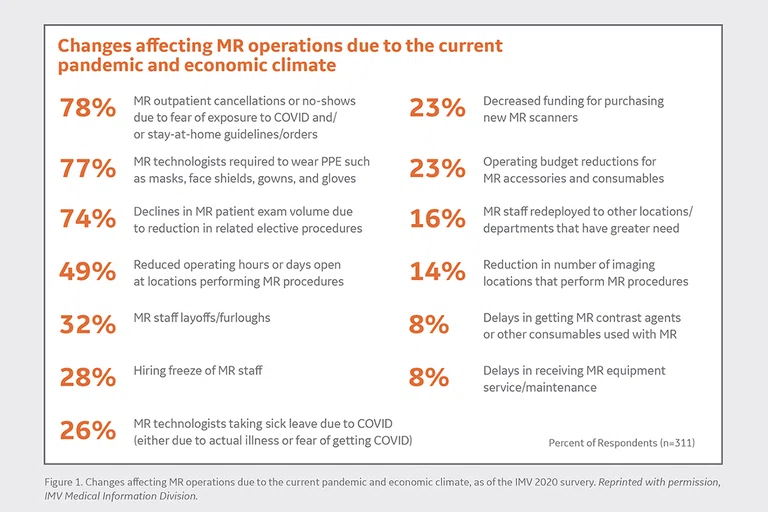result
2. Malhotra A, Wu X, Fleishon HB, Duszak R Jr, Silva E 3rd, McGinty GB, Bender C, Williams B, Pashley N, Stengel CJB, Naidich JJ, Hughes D, Sanelli PC. Initial Impact of COVID-19 on Radiology Practices: An ACR/RBMA Survey. J Am Coll Radiol. 2020 Nov;17(11):1525-1531. doi: 10.1016/j.jacr.2020.07.028. Epub 2020 Aug 4. PMID: 32853538; PMCID: PMC7402108.
1. Kaye AD, Okeagu CN, Pham AD, et al. Economic impact of COVID-19 pandemic on healthcare facilities and systems: International perspectives [published online ahead of print, 2020 Nov 17]. Best Pract Res Clin Anaesthesiol.2020;doi:10.1016/j.bpa.2020.11.009.
3. IMV 2020 MR Market Outlook Report. Available at https://imvinfo.com/product/2020-mr-market-outlook-report/.


PREVIOUS
${prev-page}
NEXT
${next-page}
Subscribe Now
Manage Subscription
FOLLOW US
Contact Us • Cookie Preferences • Privacy Policy • California Privacy PolicyDo Not Sell or Share My Personal Information • Terms & Conditions • Security
© 2024 GE HealthCare. GE is a trademark of General Electric Company. Used under trademark license.
COVID-19
IMV reports on MR productivity and workflow during COVID-19
IMV reports on MR productivity and workflow during COVID-19
The impact of COVID-19 on radiology practices and hospitals is significant. The American Hospital Association estimates $202.6 billion in lost revenue in 2020 for US hospitals1. Imaging volumes declined between 56% and 64% in nearly all US radiology practices, with outpatient centers impacted the most2.
IMV, a leader in US-based market research and online publishing for the medical imaging and clinical diagnostic instruments market, recently published its 2020 MR Market Outlook Report3. From an all-time high in 2019, MR procedures were down 35% in 2020. Respondents anticipating increases in both volumes and revenue instead saw them drop precipitously in 2020.
"All imaging modalities experienced a downturn in procedures, particularly with mammography, which was hit hard in April 2020, when patient volume was down 70 percent. We estimate that CT procedures declined 20% as of year-end 2020, so not as hard hit as MR," says Lorna Young, Senior Director, Imaging Insights at IMV. PET imaging fared better, likely due to oncology procedures not being cancelled at the same level as elective procedures. Young adds that over 70% of survey respondents said MR volumes declined due to reductions in related elective procedures. Only 2% of respondents said their MR imaging operations were "not impacted at all" by COVID-19.
MR procedures performed on outpatients took the biggest hit in volume due to COVID-19, having decreased from 79% of total MR procedures in 2019 to 70% in 2020. Interestingly, MR procedures performed on an emergency basis increased from 7% to 11% and those performed on inpatients increased from 13% to 19% of the total procedures performed in 2020.
The top change affecting MR operations was cancellations and no-shows, reported by 78% of the respondents.
"Radiology, in general, can learn from PET imaging where their schedule is highly dependent upon patients showing up for the exam," Young says. The use of radiopharmaceuticals in PET requires a robust scheduling and confirmation process because of the half-life of many isotopes. A missed appointment often translates to wasted radiopharmaceuticals, costing the facility more money.
"With the top change in MR operations being cancellations and no-shows, it may benefit MR departments to strengthen their patient reminder and communications processes to assure patients of steps being taken for their safety. For instance, some hospitals have provided a separate pathway for patients to enter the MR suite due to COVID-19," Young says. "Many MR departments were added onto an existing hospital or are located in an outpatient suite on the hospital campus due to siting requirements for MR magnets. Giving the patient that assurance that they do not have to walk through the hospital and can enter the department through a separate or dedicated entrance could go a long way to helping reduce cancellations and improving workflow."
There is also the need to screen patients for the type of mask they are wearing. Some masks have metal around the nose area, which could lead to patient burns. Young notes that some MR departments are now giving their patients masks that are appropriate for use in the MR suite.
Productivity remains key
More than half (57%) of respondents reported adding time to each patient slot for scheduled MR procedures due to disinfection routines and other COVID-19-related issues. The average time slot increase was 10.5 minutes, although hospitals with 400 beds or more reported adding 13 minutes. More than 90% had already strengthened cleaning and disinfecting protocols for MR equipment and rooms at the time of the survey (August-September 2020).
Nearly 30% of the MR procedures performed by hospitals with 400 beds or more used MR to image COVID-19 patients for assessing patients for (or with) the coronavirus, much higher than the average for all imaging sites of 8%.
However, respondents reported that after scanning a COVID-19 patient, rooms have been cleaned differently – Young suspects for a more thorough cleaning of the scanner and bore – and the room has been left vacant/unused for 30 to 45 minutes. This additional time is likely to allow for air exchange per ACR guidelines. In some sites with multiple MR systems on the same air ventilation system, the other room has been often unused for that same time period, too.
"Productivity throughout the entire MR imaging process is extremely important, from the front end of positioning patients to reduced scan time and image processing and interpreting the images on the back end," she adds. "Some may look to AI or new software that delivers higher throughput as part of the solution. Regardless of whether the need for scan time is for clinical image quality or improved workflow, the respondents want shorter scan times. This is not just an effect of COVID-19; we saw this in the 2019 survey when we reported the highest MR volumes to date."
For clinical efficiency, AI was noted as a way to improve image quality and to help all aspects of workflow. In fact, several respondents mentioned that AI should be used in the front end (positioning and scan prescription) as well as the back end (image processing). Other features such as motion-free abdominal imaging or technologies to reduce motion artifacts would either be acquired or expanded by one-third of the respondents.
Many sites are now experiencing an increased backlog in MR procedures due to COVID-19-related shutdowns. Staffing may still be down, with staff reductions due to the pandemic, while the increased backlog is putting pressure on MR operations. Getting patients in and out efficiently seems to remain a key concern – not just for patients, but for the staff as well.











